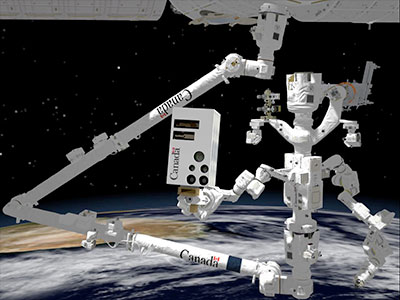A contract to develop a new advanced space vision system that will be mounted on Dextre was announced today [Jan. 7] by the Honourable Navdeep Bains, Minister of Innovation, Science and Economic Development and Minister responsible for the Canadian Space Agency (CSA). Minister Bains was joined by Greg Fergus, Parliamentary Secretary, and Sherry Romanado, Member of Parliament for Longueuil-Charles-LeMoyne. The contract, worth $1.7 million, was awarded to Neptec Design Group Ltd. of Ottawa, Ontario, to develop the design for the system, which will be launched in 2020.

The vision system will use a combination of three sensors — a 3D laser, a high-definition camera and an infrared camera — to support the inspection and maintenance of the aging infrastructure of the International Space Station (ISS). The vision system can also assist in docking of spacecraft visiting the Station.
Dextre, the CSA's robotic helper on board the ISS, will use the system to inspect the Station's external surfaces and sleuth out signs of damage. The harsh environment of space takes its toll on the Station: in addition to the natural aging of the orbiting lab's materials, the Station is regularly hit by small meteorites and orbital debris. Roughly the size of a microwave oven, the new vision system will reveal damage that in some cases remains hidden to the naked eye, or that is located in places that are hard to reach or difficult to see.
This investment in space technology ensures Canada remains a world-class innovator at the forefront of space activities and a reliable international partner in space exploration. It furthers innovation and technology development that will have benefits for Canadians on Earth.
- This technology builds upon a legacy of a long line of Neptec vision systems, including a laser camera system on Canadarm2 that was used to inspect the tiles of the US Space Shuttle. Rendezvous and docking sensors were also used on board each of Orbital ATK Cygnus spacecraft to assist the resupply ship in docking with the ISS.
- Regular inspections are crucial for keeping the ISS healthy and operational. Today, this is done either by cameras on Canadarm2 and Dextre, crew photos taken from inside the ISS or by sending astronauts out on spacewalks to take close-up photos, which is always risky.
- Dextre's new vision system will be operated by mission controllers on the ground at NASA's Johnson Space Center in Houston, Texas, or at the CSA's headquarters in St-Hubert, Quebec.
- The system's imagery will be available to the public, who will see the ISS as they have never seen it before.












